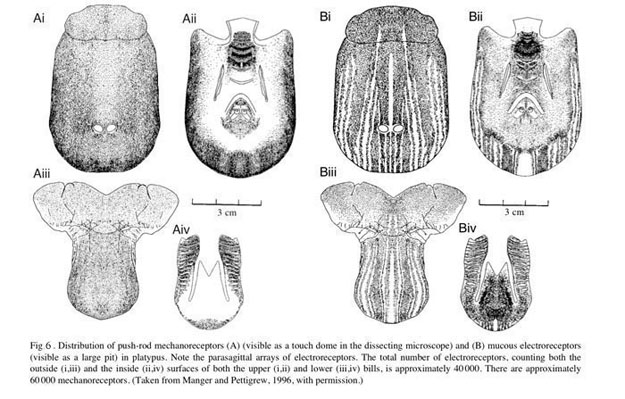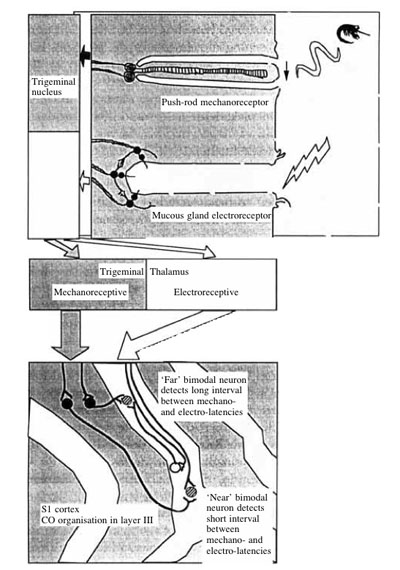Electroreception in Platypus (Ornithorhynchus anatinus)
Biology 342 Fall 2010
Author:
Emily Fong
| Home | Phylogeny | Ontogeny | Mechanism | Adaptative Value | References | Course Home |
Mechanism
Three different kinds of receptors have been identified in the bill skin of monotremes, electroreceptors and mechanoreceptors. The platypus integrates information from both its electroreceptors and mechanoreceptors, processing and using it create a map and pinpoint the location of its prey.

Source: Pettigrew (1999)
Mechanoreceptors are often called "push-rod" mechanoreceptors, as they contain sensitive epithelial rods that are free along their lengths, but are attached at the base. The afferent nerve fibres at the base of the push rod are activated by displacements caused by impulses delivered to the tip, allowing the platypus to detect the water displaced by the tail flicks of their prey. Mechanoreceptors, therefore, can detect physical stimuli presence in the water.
Two types of electroreceptors appear as pits formed in the secretory ducts of the serous and mucous glands, each surrounded by a petal-like arrangement of epithelium that opens when the bill is immersed in water (see Figure 6.). Serous electroreceptors have a smaller pit, and are located more densely at the anterolateral edges of the bill. Mucous electroreceptors are larger, and are found in stripe-like parasagittal arrays over the bill surface. The innervation of the electroreceptors is complex, and have as many as 16 different afferent nerve fibres forming specialized endings. Electroreceptors respond to changes in electrical stimulation.
Figure 7. Stimuli path, from receptors to neocortex (Pettigrew, 1999).
Bimodal neurons respond to both electrical and mechanical stimuli in the water (see Figure 7). The information is sent via the trigeminal nerve to the thalamus, where it is sent to the platypus's elaborate neocortical structure, comprised of tangential stripes of mechanoreceptive neurons interlocked with stripes of electroreceptive neurons (Pettigrew, 1999).
Platypus can detect stimuli that generate field strengths as low as 20 μV cm-1 (Manger & Pettigrew, 1996). There is a pronounced directionality in the electroreceptive system in platypus, with the axis of greatest receptor sensitivity going outwards and downwards. This directionality corresponds with platypus swimming behavior, as platypus swing their heads backwards and forwards in a roughly sinusoidal motion while swimming. The platypus is able to create a map of the environment around it to locate the prey by integrating the information both types of receptors are receiving and orienting themselves in a highly directional manner.
